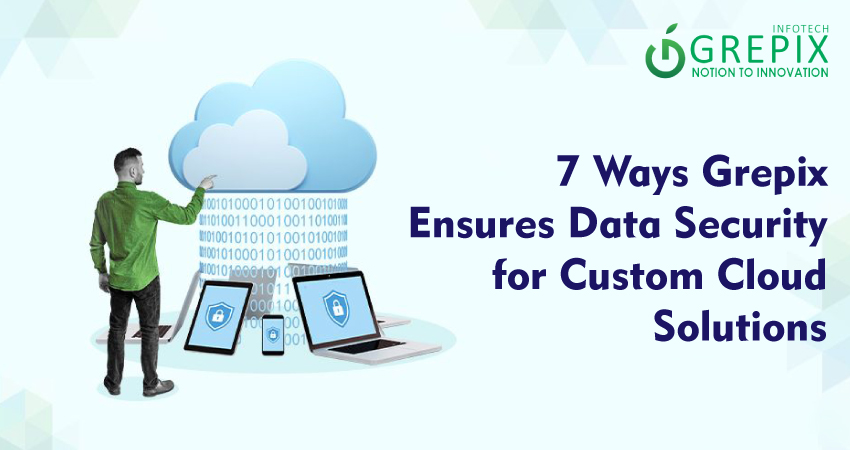7 Ways Grepix Ensures Data Security for Custom Cloud Solutions
Grepix is a leading technology solutions provider specializing in custom cloud applications that cater to various industries such as fintech, healthcare, e-commerce, and logistics. Known for its innovative approach and customer-centric mindset, Grepix doesn't just build cloud solutions it fortifies them with some of the most advanced data security measures available.
In today’s digital business environment, cloud adoption is no longer optional; it’s the backbone of scalability and agility. But with that advantage comes an increased responsibility to protect sensitive data from breaches, theft, and unauthorized access.
Grepix’s reputation rests not only on delivering high-performing cloud applications but also on ensuring enterprise-grade security that meets and often exceeds industry standards. With a dedicated team of cybersecurity experts, the company combines technology, process, and policy to create a resilient security framework for every project.
Grepix, a leading mobile app development company, goes beyond building innovative solutions by prioritizing top-tier data security for custom cloud applications. In this article, we explore seven powerful strategies Grepix uses to protect sensitive information. These include end-to-end encryption, ensuring data is secure in transit and at rest, and multi-factor authentication to block unauthorized access. Their secure API development approach safeguards integrations, while regular security audits and penetration testing identify and fix vulnerabilities before they’re exploited. Grepix also implements reliable backup and disaster recovery plans to maintain business continuity, complies with regulations like GDPR, HIPAA, and ISO 27001, and invests in continuous employee security training to minimize human error. This layered approach builds trust, ensures compliance, and enhances resilience. By choosing Grepix, businesses gain not only high-performance cloud solutions but also a partner committed to keeping their data safe in an increasingly risky digital world.
Why Data Security is Non-Negotiable in the Cloud Era
The shift from traditional on-premise systems to cloud infrastructure has unlocked immense benefits cost efficiency, remote accessibility, and rapid deployment. However, this transition also brings with it heightened cybersecurity threats. Cybercriminals have evolved from lone hackers into organized, well-funded cybercrime networks, making businesses vulnerable to ransomware, phishing, data leaks, and insider threats.
For industries such as healthcare or finance, a single breach can mean millions in financial losses, regulatory penalties, and permanent brand damage. That’s why Grepix treats security not as an add-on but as an integral design principle. Whether it’s through encryption, authentication protocols, or compliance certifications, every solution is built on the principle of “security by design”.
The Rising Threat Landscape in Cloud Computing
Data security threats are not just increasing they’re evolving. Attackers now exploit zero-day vulnerabilities, misconfigured cloud settings, and unsecured APIs to infiltrate networks. Moreover, insider threats, whether malicious or accidental, remain a significant challenge.
Grepix stays ahead of these risks by continuously monitoring threat intelligence, adapting its security policies, and deploying cutting-edge tools for threat detection and response. This proactive stance ensures that clients aren’t reacting to breaches they’re preventing them.
Way 1 End-to-End Data Encryption
Encryption in Transit and at Rest
One of the core principles in Grepix security framework is data encryption, which ensures that sensitive information is unreadable to unauthorized users. Data in transit moving between user devices and cloud servers is protected using Transport Layer Security (TLS) protocols, preventing eavesdropping or interception. Data at rest, stored within cloud servers, is safeguarded with Advanced Encryption Standard (AES-256), the same technology used by governments and financial institutions.
Use of Industry-Standard Protocols like AES-256
AES-256 encryption is virtually unbreakable with current computing power, making it the gold standard for protecting stored data. Grepix implements key management systems (KMS) to control access to encryption keys, ensuring only authorized personnel can decrypt sensitive files.
Additionally, the company ensures encryption compatibility across multi-cloud and hybrid cloud environments, making it easier for businesses to adopt secure solutions without operational friction.
Benefits of Comprehensive Encryption
- Confidentiality: Unauthorized users can’t read encrypted data.
- Integrity: Prevents tampering or altering of sensitive files.
- Compliance: Meets regulatory requirements like GDPR and HIPAA.
- Trust: Demonstrates a strong commitment to safeguarding client data.
Grepix’s encryption-first approach transforms raw security measures into business value, fostering client trust and reducing long-term cybersecurity risks.
Way 2 Multi-Factor Authentication (MFA)
Why Passwords Alone Are Not Enough
Passwords, no matter how strong, are often the weakest link in data security. They can be stolen through phishing attacks, brute force hacking, or simply guessed due to poor user habits. Grepix tackles this vulnerability with multi-factor authentication (MFA), adding extra layers of identity verification beyond just a password.
MFA Implementation Across All Access Points
Grepix enforces MFA across all login portals, whether for client dashboards, administrative tools, or API access. This could include:
- One-Time Passwords (OTPs) sent via email or SMS
- Authenticator apps like Google Authenticator
- Biometric verification such as fingerprint or facial recognition
By requiring multiple proofs of identity, MFA drastically reduces the chance of account takeovers.
How MFA Reduces Unauthorized Access Risks
If a hacker manages to steal a user’s password, MFA acts as a dead-end. Without the second or third authentication factor, unauthorized access becomes nearly impossible. This not only safeguards sensitive data but also prevents costly breaches that could harm a company’s financial stability and reputation.
Way 3 Secure API Development
Role of APIs in Custom Cloud Solutions
APIs are the backbone of modern cloud solutions, enabling data exchange between different software systems. For example, a healthcare cloud platform might use APIs to share patient data with pharmacy systems securely. However, insecure APIs can become open doors for hackers.
API Threats and Vulnerabilities
Common API security risks include:
- Broken authentication
- Data exposure due to poor filtering
- Injection attacks such as SQL or XML injections
- Rate limiting bypasses
These vulnerabilities can lead to massive data leaks or service disruptions.
Grepix’s Secure API Design Principles
Grepix employs security-first API development, which includes:
- Strict authentication and authorization
- Input validation to prevent injection attacks
- Rate limiting to prevent denial-of-service (DoS) attacks
- Regular vulnerability scans and patching
This disciplined approach ensures that APIs remain secure, stable, and scalable without sacrificing performance.
Way 4 Regular Security Audits and Penetration Testing
Importance of Proactive Threat Detection
Instead of waiting for a breach to happen, Grepix takes a proactive approach. Regular security audits evaluate the entire system architecture, from code to configurations, identifying vulnerabilities before they can be exploited.
Internal vs. Third-Party Audits
Grepix conducts internal audits to maintain continuous oversight but also partners with independent cybersecurity firms for unbiased third-party evaluations. These external audits bring fresh perspectives, uncovering blind spots that in-house teams might overlook.
How Penetration Testing Strengthens Security
Penetration testing simulates real-world hacking attempts to expose vulnerabilities. Grepix’s penetration testers use both automated tools and manual techniques to mimic sophisticated cyberattacks. The findings are then used to patch weaknesses, improve defense mechanisms, and ensure that clients’ cloud solutions can withstand real threats.
Way 5 Data Backup and Disaster Recovery Planning
Why Backup Is Critical in Cloud Solutions
Even the most secure systems can face unexpected failures from natural disasters to ransomware attacks. Without a reliable backup system, data loss can be catastrophic. Grepix treats data backup as a business continuity necessity, not an optional feature.
Grepix’s Redundant Storage Systems
Grepix uses geo-redundant storage, meaning data is duplicated in multiple data centers across different locations. If one server fails, another takes over instantly, minimizing downtime. Backups are also encrypted and stored in secure, access-controlled environments.
Disaster Recovery Best Practices
Grepix’s disaster recovery plan includes:
- Regular backup schedules
- Automated failover systems
- Data restoration testing
- Clear recovery time objectives (RTOs) and recovery point objectives (RPOs)
By combining these practices, Grepix ensures that clients can resume operations quickly even in the face of major disruptions.
Way 6 Compliance with Industry Regulations
GDPR, HIPAA, and ISO Standards
Data security isn’t just about defending against cybercriminals it’s also about meeting legal and industry requirements. Grepix aligns its cloud solutions with globally recognized regulations such as:
- GDPR (General Data Protection Regulation) – For protecting personal data of EU citizens.
- HIPAA (Health Insurance Portability and Accountability Act) – For safeguarding medical information in healthcare.
- ISO/IEC 27001 – For information security management systems.
By adhering to these frameworks, Grepix ensures that every solution is legally compliant while maintaining high operational performance.
How Compliance Enhances Trust
When businesses comply with these standards, they send a clear message to customers: “Your data is safe with us.” Compliance builds confidence not just with clients but also with stakeholders, regulators, and partners. For industries like finance and healthcare, compliance can even be the deciding factor when selecting a service provider.
Grepix’s Certification and Compliance Processes
Grepix undergoes regular certification renewals to ensure it stays ahead of evolving compliance standards. The company maintains detailed documentation, conducts internal training, and integrates compliance checks directly into its development lifecycle. This prevents compliance from becoming a last-minute scramble and instead makes it an ongoing, embedded practice.
Way 7 Employee Security Training
Human Error as a Major Security Risk
You can have the most advanced firewalls and encryption in the world, but one careless click on a phishing email can compromise the entire system. Studies show that over 80% of data breaches are linked to human error. Grepix acknowledges this reality and treats employee training as a critical pillar of security.
Grepix’s Continuous Training Programs
Rather than relying on a single onboarding session, Grepix implements ongoing security training that covers:
- Recognizing phishing and social engineering attempts.
- Best practices for password management.
- Secure use of company devices and remote access.
- Incident reporting procedures.
The training is delivered through interactive workshops, real-world simulations, and regular knowledge assessments to keep employees engaged and informed.
Building a Security-First Culture
Security isn’t just a department it’s a mindset. Grepix fosters a culture where every employee, from developers to project managers, understands their role in protecting client data. This collective responsibility ensures that security is woven into every decision, every feature, and every line of code.
Conclusion
In today’s rapidly evolving digital world, securing data in the cloud is no longer optional it’s a business necessity. Grepix, a leading mobile app development company, has positioned itself as a trusted partner by embedding security into every stage of its custom cloud solution development process. From end-to-end encryption and multi-factor authentication to secure API design, regular security audits, and robust disaster recovery plans, every measure is meticulously implemented to safeguard sensitive information.
By staying compliant with global standards like GDPR, HIPAA, and ISO 27001 and fostering a security-first culture among employees, Grepix ensures that threats are mitigated before they can become breaches. This layered, proactive strategy not only protects data but also builds lasting trust with clients.
Choosing Grepix means choosing a cloud partner that prioritizes security as much as performance ensuring your business remains resilient, compliant, and ready for the future.
FAQs
1. How does Grepix handle customer data privacy?
Grepix uses encryption, strict access controls, and compliance checks to ensure all personal data is handled securely.
2. What makes Grepix’s cloud solutions more secure than others?
Their approach combines cutting-edge technology, regulatory compliance, and continuous monitoring.
3. Does Grepix offer data security for hybrid cloud models?
Yes, Grepix designs security strategies tailored to multi-cloud and hybrid infrastructures
4. How often does Grepix conduct security audits?
Audits are performed regularly throughout the year, including both internal reviews and third-party evaluations.
5. Can Grepix customize security measures for different industries?
Absolutely—security frameworks are adapted based on industry-specific regulations and risks.
Launch your vision with our mobile app development company, where innovation meets excellence to create cutting edge mobile solutions."







